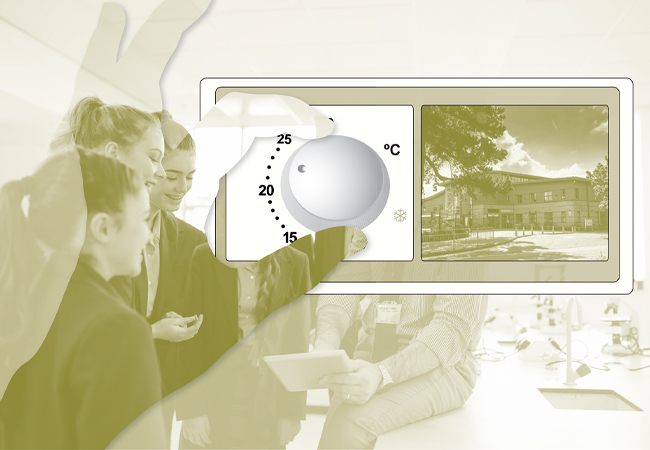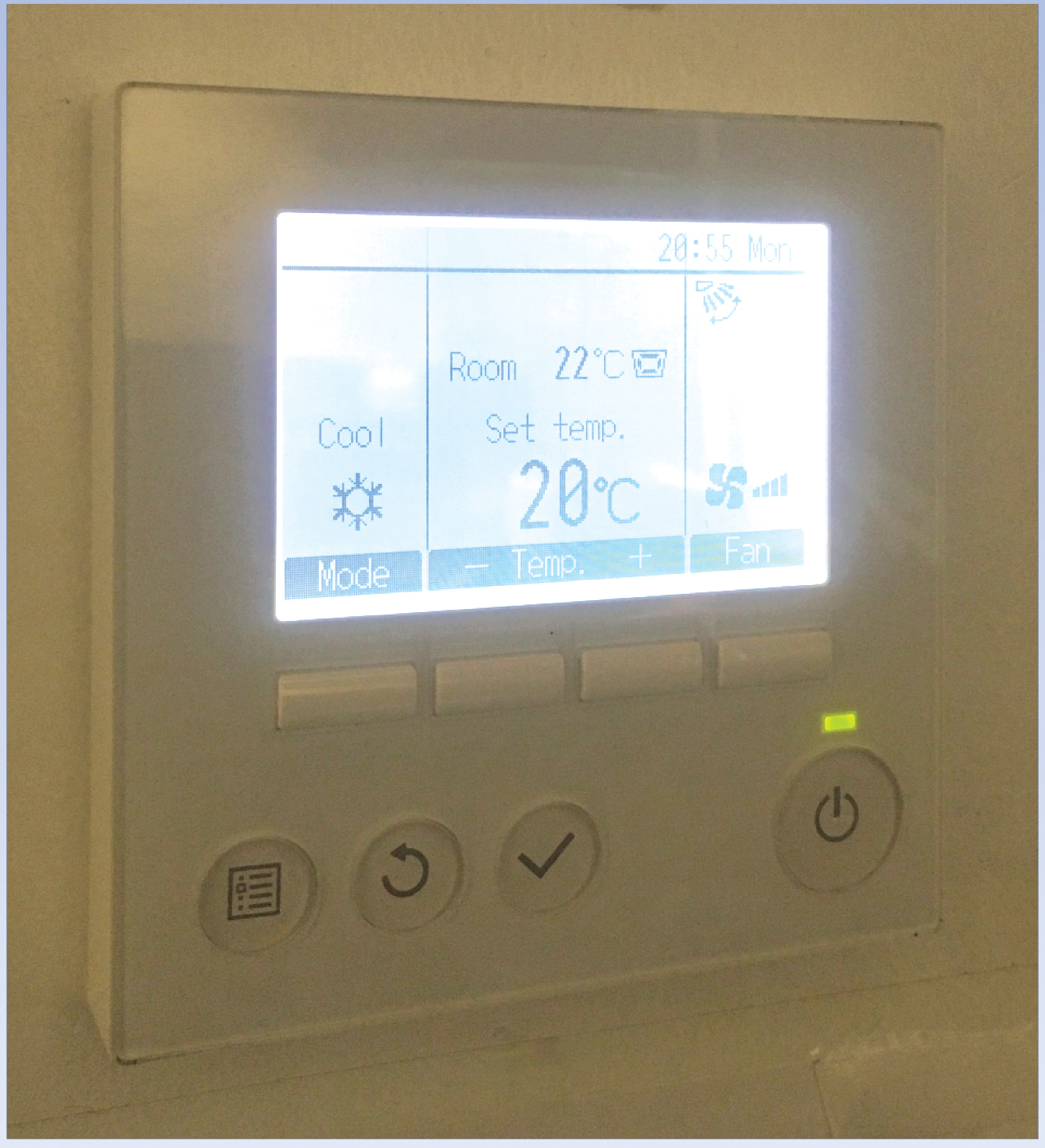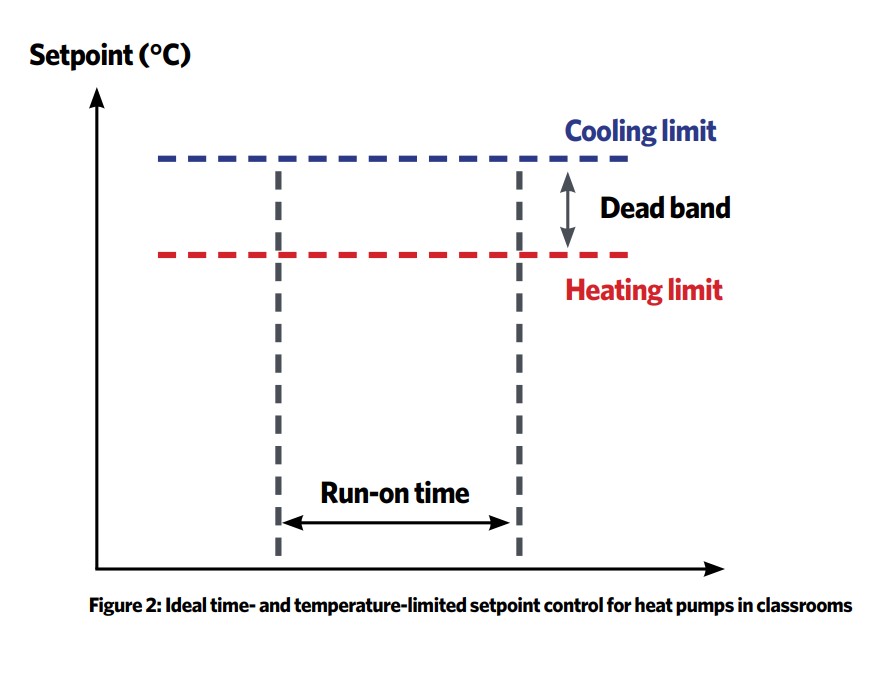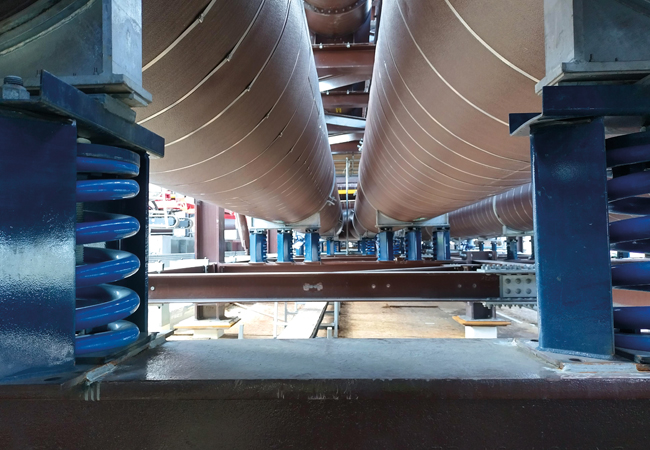
There is a huge opportunity for schools to save thousands of pounds in energy bills by making simple adjustments to heating and cooling controls.
The extent of possible savings are demonstrated in a recent study carried out at Parrs Wood High School in Manchester. An analysis of five million data points identified areas of significant energy waste, which enabled the school to reduce its electricity bill by £9,000 – a saving of 7% (equivalent to 31 tonnes of CO2 per year). The data revealed that 80% of the associated electricity consumption was waste energy caused by HVAC units running outside of occupancy hours because of poor control. Changes to controls reduced this waste to 1%.
The project gave pupils the opportunity to understand the link between poor HVAC controls and carbon emissions. Through the student CO2 environmental team, they were also able to make a direct impact on energy costs. In fact, they saved £1,000 alone with a bit of lateral thinking and a matchstick.
The study
The analysis looked at 100kW of discrete electrical space heating and cooling units over nine months. Data was logged at two-minute intervals, resulting in five million data points – the equivalent of 20 years’ worth of data.
Parrs Wood has recently increased its use of IT1 and expanded its teaching space. This has resulted in more electrical HVAC equipment, such as air conditioning units for comfort cooling in IT rooms, and heat pumps and electric radiators for conditioning new spaces. We found space-conditioning equipment to be the most problematic HVAC equipment to control, resulting in long overrun times and considerable wasted energy. It was decided to monitor this equipment.
To assess the energy efficiency of controls, low-cost temperature loggers were used to monitor unit operating times. For heat pumps and air conditioning, the compressor was monitored because it is responsible for the majority of electricity consumption. An Excel spreadsheet formula was used to establish the percentage of use occurring in and out of building occupancy, typically from 8am to 4pm. In trials, the accuracy of this low-cost monitoring system was +-3%.

Figure 1: Typical heat-pump room controller for use by occupants
The project also monitored thermal comfort. Air temperatures were logged and classroom occupants were assessed using a thermal comfort survey based on the BUS occupant survey2. It was completed by occupants in classrooms with each of the control types, and the results checked for statistical significance. Allowing occupants on/off control of units resulted in the greatest level of thermal comfort. Other variables, such as setpoint control and fan speed, were found to be less significant. This implies that, despite being shown how to use the controllers, occupants revert to using them for basic on/off control only.
In part, this is explained by the perceived complexity of controls. This was investigated further by testing occupants on the meaning of symbols commonly found on room controllers. The results were checked for statistical significance and showed that teachers and students understood about 50% of the symbols; only service engineers scored 85% or above.
Results and recommendations
Air conditioning and heat-pump control in shared classrooms: The classrooms were either heated and cooled by a heat pump, or heated by wet central heating with an air conditioning unit providing comfort cooling. Five common types of control were assessed and, as a minimum, all rooms had a room controller for occupants to adjust. The controls can be divided into two groups: those with full occupant on/off control and those with on/off control limited by a run-on timer.
What to avoid
Full occupant on/off control (ie not time limited): This is the most common way room controllers remain configured after installation and, while it gave high levels of thermal comfort, occupants forgot to turn units off, resulting in long overrun periods. Annual use was 2,750 hours, 80% of which was out of occupancy.
Setpoint control alone: An early version of our BEMS software only allowed occupants setpoint control, not on/off control, so units had to be enabled on the BEMS all day (8am to 4pm). This at least stopped units overrunning outside of occupancy hours. It was hoped that, during the day, occupants would use the room controller to adjust the setpoint, bringing the unit on and off as required. In practice, occupants controlled room temperature using windows, which resulted in units running unnecessarily long hours (80% of occupancy, as opposed to only 33% under the best control).
What worked well
Time-limited occupant on/off control: Allowing occupants to turn units on, but with a run-on time of only two hours, delivers good thermal comfort, but with the advantage of stopping units from running when not needed. This gave the lowest annual operating time of 600 hours (only 33% of occupancy hours during the cooling or heating seasons) and reduced out-of-occupancy waste from 80% to 1%.
Time limiting was achieved in three, equally effective ways: a password-protected run-on time, set on the room controller (only available on more recent models); a ceiling-mounted occupation sensor (some newer room units come with one built in); and, for those connected to the BEMS, software, developed to turn them off after two hours. The BEMS control has the advantage of being able to make adjustments quickly and easily for multiple rooms at once.
Restricting maximum and minimum setpoints: We found occupants often select excessive setpoints (for example, heating 30°C or cooling 14°C), which increases energy consumption significantly. An in-house survey found extreme setpoints were used because:
- People believed the room would heat or cool more quickly
- People did not dress appropriately for the season
- Occupants become used to controlling temperature using windows, because they are easier to adjust than room controllers
- In schools, occupants change room regularly and may not remain long enough to appreciate the extreme temperatures ultimately achieved (which may be some time later when the room is not in use).
Giving occupants full control of the setpoint perpetuated these practices, despite an educational campaign and posters in each room. Limiting the cooling setpoint to no lower than, say, 24°C – and heating setpoints to no higher than 20°C – encourages behaviour change with regard to clothing and use of windows, and saves significant amounts of energy. Again, this was achieved using password-protected room controllers or on the BEMS. Figure 2 shows the ideal time- and temperature-limited setpoint control.

Electric radiator controls in transient spaces
Four types of controls, three of which complied with Building Regulations, were monitored. They can be divided into two groups – those that were easily tampered with and those that were not.
In transient spaces, such as corridors, occupants do not have to endure excessive temperatures for long, and tend to use windows to control temperature. It is impossible for busy staff to check and correct radiator settings on a regular basis, and we found that giving occupants no control at all gave the best results.

Figure 3: A typical ‘tamper-proof’ cover takes students about 60 seconds to open
The occupant controls outlined below resulted in high annual operating times of around 4,000 hours, with 67% being outside of occupancy. With no occupant control, the annual operating time fell to just 850 hours, with only 1% outside of occupancy. Windows were left open far less frequently and the air temperature log showed it was within the CIBSE recommended range for corridors.
What to avoid
These occupant controls should be avoided: simple on/off switch (non-compliant with the Building Regulations); an override switch (so the unit remains on permanently); time clock; thermostat; night setback temperature. These all resulted in appalling results, despite some manufacturers’ claims that they were tamper-proof (Figure 3).
In an attempt to avoid tampering by occupants, a radio-controlled system was installed, with radiators operated by a central time clock that was not accessible to occupants. However, many of these systems have day and night setback thermostats on the radiator (Figure 4). These are easily tampered with and the night setback temperature was frequently set at its highest level of 21°C so that the unit ran 24/7 trying to achieve this.
What worked well
To remove all occupant control, the student efficiency team locked the day and night thermostats in place using a concealed match stick (day 18°C, night 5°C for frost protection). Their ‘matchlock’ system ensured that, once turned off by the central timer, the units stayed off, saving the school around £1,000 a year with a payback time of just 19 minutes!
That simple time- and temperature-limited occupant control will give the best results in classrooms, and no occupant control will work best in transient spaces seems obvious. What’s not clear is why so many controls are not configured in this way. Some large hotel chains have time-limited controls in rooms, but it is not common practice elsewhere.

Figure 4: Avoid occupant-controlled day and night setback thermostats
We conducted a national survey of 80 institutions (schools, universities, councils, fire and rescue, police and NHS estates), and found that 89% suffered similar poor control issues, with the majority blaming contractors for installing over-complicated controls. The problem is likely to be compounded by regulations such as EcoDesign Lot 20, which assumes more complex controls will result in better energy efficiency.
However, Lot 20 control efficiencies are not measured values, but ‘expected’ ones3 based on the assumption that occupants will adjust them to give optimum performance, which we have shown not to be the case.
Rather than increased complexity, we need standardised simplification of controls, combined with legislation/guidance on how to actually configure them for efficient use.
About the author
Chris Baker is a science teacher and coordinator of the student CO2 efficiency team at Parrs Wood High School.
For further information, email c.baker@parrswood.manchester.sch.uk
References
- Sung-Min Hong et al, UCL. (2014). Improved benchmarking comparability forenergy consumption in schools. London:
- Useable Buildings. (2017). BUS occupant survey
- Electric radiators direct (2017): Lot 20 Explained: What Does This Mean for Electric Heating?






